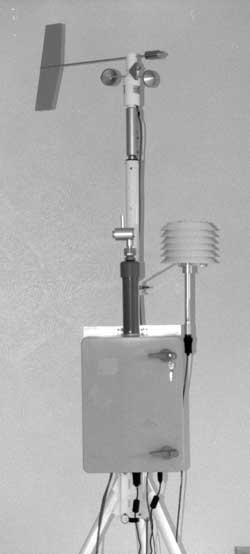
Back | Next | Home
Missoula Technology &
Development Center
 |
Table
of Contents Back | Next | Home |
Missoula Technology & Development Center |
Evaluation of Optical Instruments for Real-Time Continuous Monitoring of Smoke Particulates
The optical real-time, continuous particulate monitors used in the evaluation may be classified into two types: predominantly light-scattering instruments and predominantly light-absorbing instruments. Light-scattering instruments, called nephelometers, measure the amount of light scattered over a known path length and then use a mathematical relationship to estimate the aerosol mass concentration. The particle light scattering (bsp) value is determined by illuminating particles, individually or as a group, and measuring the scattered intensity at different orientations from an incident light source. The orientation of the light source to the particles and receiver will determine whether the instrument is primarily back scattering, forward scattering, or total integrating.
Light-absorbing instruments, called aethalometers, quantify the light-absorbing aerosol (black carbon, for example) by depositing the aerosol on a quartz-fiber filter and measuring the light transmission or reflectivity. Aethalometers also compute measured light attenuation due to black carbon.
The Met One Model GT-640 particulate monitor (figure 1) is a complete ambient air sampler using a forward light-scattering detector and built-in data logger. A laser optical sensor detects and measures particulate concentrations up to 10,000 µg/m³. Built-in calibration functions are included. The unit has an internal relative humidity sensor that turns on an inlet heater at 55-percent relative humidity. The monitor can be configured with either a PM10 (particulate matter finer than 10 µm) or PM2.5 (particulate matter finer than 2.5 µm) cutoff inlet. Total suspended particulate concentrations can be estimated by removing the cutoff device. Data are digitally recorded and stored with time and date information. Stored data are retrieved through an RS-232 port connected to a laptop computer or through an external modem. The logger will record concentrations automatically along with date and time, whenever power is applied. Optional connections on the bottom of the GT-640 allow various meteorological sensors to be attached. All internal components are housed in a weatherproof enclosure. The unit can be powered by an ac or dc power source.

Figure 1—The Met One Instruments
GT-640 particulate monitor with
meteorological instrumentation.
The DataRam (figure 2) is a compact, self-contained instrument that internally estimates mass concentration from the measured scattering of light. The instrument can measure particulate concentrations from 0.1 to 400,000 µg/m³, according to the vendor. The instrument continuously displays the current and time-weighted average mass concentration while logging up to 10,000 data points. Data can be downloaded from the instrument through an RS-232 port. The DataRam can be configured with either a PM2.5 or PM10 impactor head to prevent particles larger than 2.5 or 10 µm, respectively, from entering the optical chamber. For custom calibrations, or to analyze the chemical composition of particulates, the particulates can be collected on a 37-mm filter located in the instrument's base. An inline heater may also be installed for monitoring in humid conditions (the manufacturer suggests using the heater when the relative humidity is higher than 70 percent). The instrument's tubular heater is designed to heat the sampled air stream to evaporate liquid water from airborne particles or to eliminate fog droplets. The DataRam is powered by an internal rechargeable battery or by an external dc or ac power source. The DataRam has a built-in, internal calibration device.

Figure 2—The MIE DataRam.
| Back | Next Table of Contents |
Missoula Technology & Development Center |